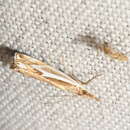Conservation Status
provided by University of Alberta Museums
Seldom encountered, but probably under collected and of no concern.
- license
- cc-by-nc
- copyright
- University of Alberta Museums
Cyclicity
provided by University of Alberta Museums
Late July to early August.
- license
- cc-by-nc
- copyright
- University of Alberta Museums
Distribution
provided by University of Alberta Museums
A North American species known from Massachusetts and New York (Fernald 1896, Forbes 1923), Ontario (Kearfott 1908), New Jersey (Forbes 1923), Quebec (Forbes 1923, Handfield 1997); and from Michigan (Scholtens 1996). In Alberta, known only from the Edmonton area.
- license
- cc-by-nc
- copyright
- University of Alberta Museums
General Description
provided by University of Alberta Museums
A small Crambus (18-22 mm wingspan). Forewing yellowish or brownish ochre; scimitar-shaped silver streak unusually wide, almost reaching the costa, sometimes with a broad brown longitudinal ray, strongly toothed below; no silver patch between streak and subterminal line but middle of terminal space white; subterminal line zigzag; black, somewhat elongate dots in the lower part of the terminal line; hind wing smoky with a white fringe. There is really nothing else that is similar.
- license
- cc-by-nc
- copyright
- University of Alberta Museums
Habitat
provided by University of Alberta Museums
Mainly in bogs.
- license
- cc-by-nc
- copyright
- University of Alberta Museums
Life Cycle
provided by University of Alberta Museums
Early stages unknown.
- license
- cc-by-nc
- copyright
- University of Alberta Museums
Trophic Strategy
provided by University of Alberta Museums
Larval host plants unknown.
- license
- cc-by-nc
- copyright
- University of Alberta Museums
Crambus bidens
provided by wikipedia EN
- license
- cc-by-sa-3.0
- copyright
- Wikipedia authors and editors
Crambus bidens: Brief Summary
provided by wikipedia EN
Crambus bidens, or Biden's grass-veneer, is a moth in the family Crambidae. It was described by Philipp Christoph Zeller in 1872. It is found in North America, where it has been recorded from Massachusetts, New York, Ontario, New Jersey, Quebec, Michigan and Alberta. The habitat consists of bogs.
- license
- cc-by-sa-3.0
- copyright
- Wikipedia authors and editors

